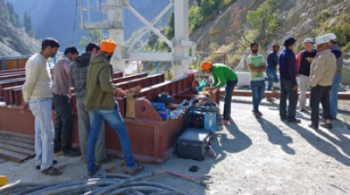STAHL CraneSystems supports Kishanganga hydroelectric power plant in the Himalayas

The arrival of the crane system in the Himalayas at 2,400 meters above sea level. Photo by STAHL CraneSystems GmbH
“If there is paradise on Earth, it is here,” the Mughal emperor Jahangir once said four centuries ago in describing the landscape of the northern Indian state of Jammu and Kashmir. Lying at the foot of the Himalayan massif, the small region is host to a variety of climate zones: from temperate and Mediterranean to subtropical and high alpine. The diversity of the climate and soil conditions forms the basis for the existence of a wide range of different plant and animal life. The idyllic countryside attracts countless trekkers every year and even filmmakers from Bollywood use the splendid setting for their productions.
To please the demands of guests for comfort and the like, a lot is being invested in India. One of the projects is the Kishanganga hydroelectric power plant that was built near the town of Bandipora on the fringes of the frontier between Pakistan and India. It is part of a large hydroelectric power station programme being implemented by the state-owned Indian power utility NHPC Ltd. (formerly National Hydroelectric Power Corporation). NHPC is being supported in its plans by the German engineering firms DSD NOELL GmbH and STAHL CraneSystems as well as by the Hindustan Construction Company from India.
To ensure continuous operation of the turbine generators of the Kishanganga hydroelectric power plant, which are meant to generate a total of 330 megawatts of electricity, it is vital that a continuous flow of water is ensured. The plan to guarantee this: to dam the Kishanganga River. As a specialist in the field of hydraulic steel structures in waterways, weirs and hydroelectric power stations, DSD NOELL GmbH planned and built a 37 m high weir. STAHL CraneSystems, a specialist in crane technology with the largest range of high-quality hoisting technology available worldwide, developed and delivered the winch system to lower the 100 t sluice.
The demands on the hoist were high as it had to work reliably in the adverse environmental conditions in the mountainous region. To ensure equal distribution of the weight, the hoist was designed in reeving of 2 x 12/2-1 and the drum manufactured in a length of L4. The final height of lift achieved after completion was 21.5 m at 2 x 150 m rope length. Thanks to the double symmetrical arrangement of the reevings, it was possible to realize perfect synchronism of the two load hooks. The total length of the winch system covers almost 9 m.
To ensure safe lowering of the sluice, the engineers from STAHL CraneSystems implemented the rope with seven-fold safety. In addition to that, they included a second brake in the winch system as safety brake, flanged directly on to the gearbox. The hoist was equipped with an overload cut-off device for each of the two load hooks and placement of the load realized separately through slack rope cut-off for each of the two hooks. The hoist is designed for its application for an ambient temperature between -25°C and +40°C. Robust, pole-changing technology with further tolerance ranges enables operation in unstable mains power supplies. Due to the air humidity, STAHL CraneSystems also equipped the panel boxes and hoist motor of the individual hoists with a heater. A hoist brake with built-in brake venting lowers the load with pauses in the event of a power failure. The weight of the load is determined continuously by the SMC multi-controller via analog measuring sensors.
The crane system was commissioned on site by the STAHL CraneSystems factory service center. Since the passes in the Himalayas are only passable for a few weeks in summer, the equipment had to be delivered in a finely defined period of time. The moment came at long last in mid-July this year: the sluice was lowered with the help of the special winch. Since then, the reservoir has been filling up day for day.
For more information, please visit: www.stahlcranes.com
News Categories
- » NEWS HOME
- » Automation & Robotics
- » Industry 4.0
- » Material Handling
- » Sensors
- » Quality & Testing
- » Machine Vision
- » Laser & Optics
- » Metalworking
- » Motion Control & Drives
- » Hydraulics & Pneumatics
- » Process Industry
- » Renewable Energy
- » Agriculture
- » Home & Office Furniture
- » Environmental Tech



